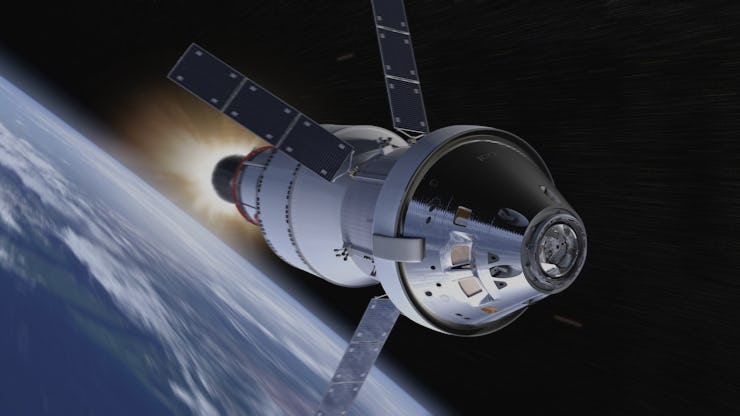NASA Nixes Plans to Send Astronauts to Lunar Orbit in 2019
We saw this coming.

Excited for Mars? Here’s some cold water to throw on those hopes and dreams: NASA has officially pushed the date for Exploration Mission 1 (EM-1), the first integrated test flight of the Orion deep-space crew vehicle and the Space Launch System (SLS) rocket, to 2019. This is hardly a surprise, but is discouraging nonetheless. Furthermore, the mission will definitely not be carrying any astronauts into space, as NASA — prodded by the White House — had been considering in the last few months.
In a hastily announced press conference on Friday — a notice went out four hours ahead of time — the space agency broke the news.
EM-1 is meant to be both the inaugural launch of SLS — the rocketry system meant to facilitate heavy-payload missions into deep space — and a more robust test of Orion by flying it out to a retrograde orbit around the moon. Friday afternoon’s announcement was held because NASA had just wrapped up a study looking into how feasible it might be to turn EM-1 from an uncrewed mission to a crewed one.
“While it’s ethically feasible,” NASA acting administrator Robert Lightfoot told reporters, “[the feasibility study] really affirmed the baseline plan we had in place.” As such, NASA is sticking with an uncrewed EM-1 flight.
The pushback to 2019 was not unexpected — there had already been rumblings that indicated there was no way NASA would meet its original 2018 launch date.
There have been reports of Trump’s advisors pushing for NASA to revive plans to send humans back to the moon and develop a larger plan to establish a permanent American presence on the surface.
Lightfoot emphasized, “the White House has been very supportive of our plan,” and that based on the study’s findings, NASA and the White House made the latest EM-1 decisions “together.” Lightfoot found the original commission of the feasibility study “typical of what a lot of new administrations do when they come in.”
William Gerstenmaier, the associate administrator of NASA’s Human Explorations and Operations Mission Directorate, explained that turning EM-1 into a crewed mission would have required about $600 million to $900 million. Orion would have to have been fitted with a slew of different life-support systems to sustain a crew for a few weeks, increase testing of an abort system, install software to allow the crew to interface with the spacecraft’s instruments, and also required ESA to speed up the construction of Orion’s service module (NASA outsources to its partners in Europe).
Gerstenmaier said the study found solutions to many of these problems, but ultimately decided the additional risk and work “didn’t seem warranted in this environment.”
Part of this has to do with what the goals behind EM-1: “really push as hard as we can” all navigation and propulsion systems on Orion, Gerstenmaier told reporters. A crewed mission would force NASA to scale back those operations into more conventional parameters, to mitigate the risk associated with that kind of testing.
In addition, the pair tried to explain why SLS and Orion have been plagued by delays for nearly the entire decade. According to Gerstenmaier, there is not so much of problem in developing new technologies for these systems as there are issues in actually building them — which is more complex than ever. “I’d say that new manufacturing is causing the delays that we’re seeing,” he said. “If you look at the amount of work we’ve accomplished, it’s pretty phenomenal overall. and that’s caused some of the delays.”
Lightfoot emphasized that programs like Apollo were built with a singular goal in mind, and given an incredibly high budget to accomplish this. Orion and SLS, by contrast, are being constructed not just with Mars in mind, but other places as well, with multiple applications. Lightfoot called it an engineering program “that will last for decades.”
“That’s the challenge for us,” he said. “We’re looking for a sustainable program here — more than one mission.”
Lastly, Lightfoot was asked directly whether President Trump had followed up on his remarks a few weeks ago that he wanted NASA to aim to send people to Mars before the end of his first or second term. Lightfoot’s only response: “They have not asked us to go to Mars by 2024.”